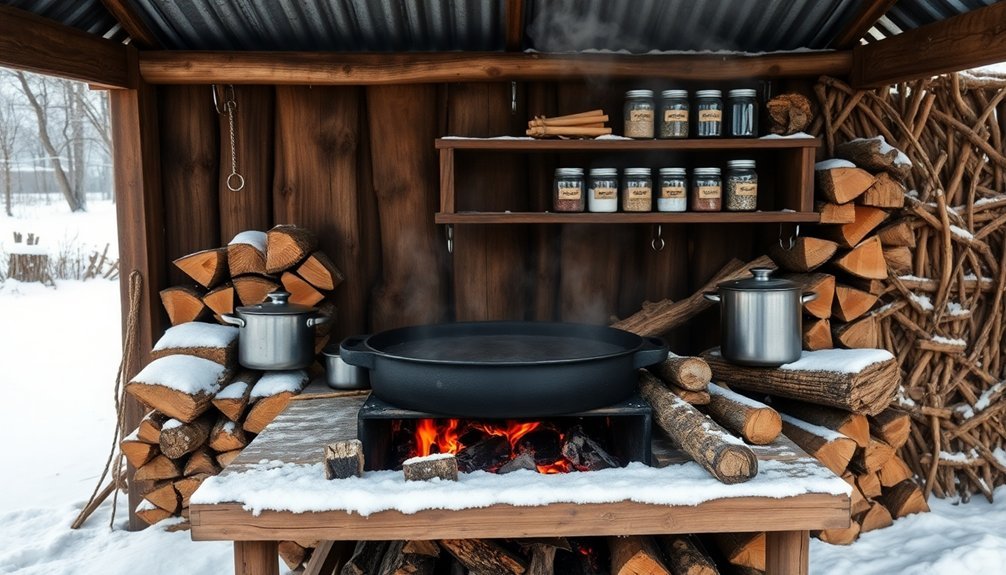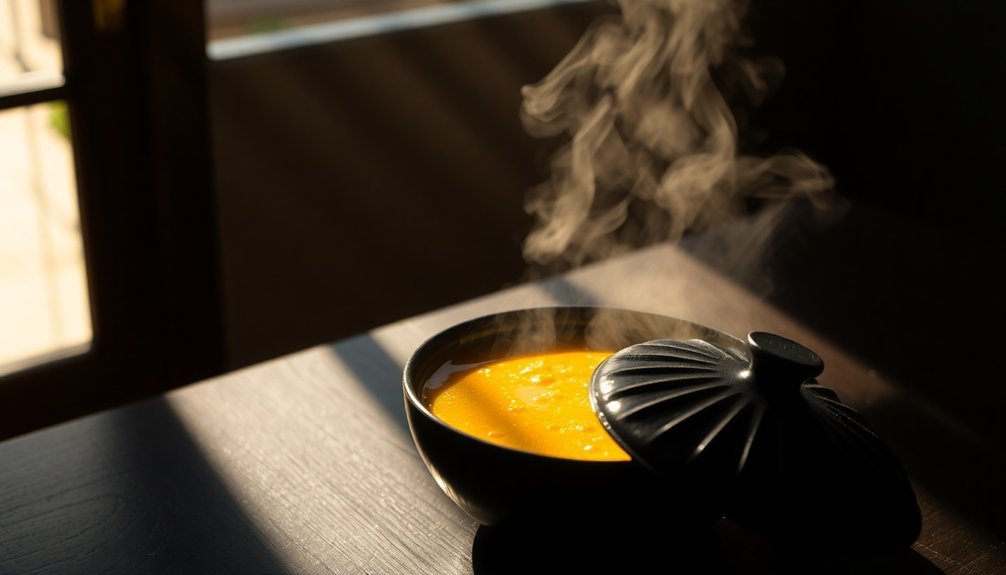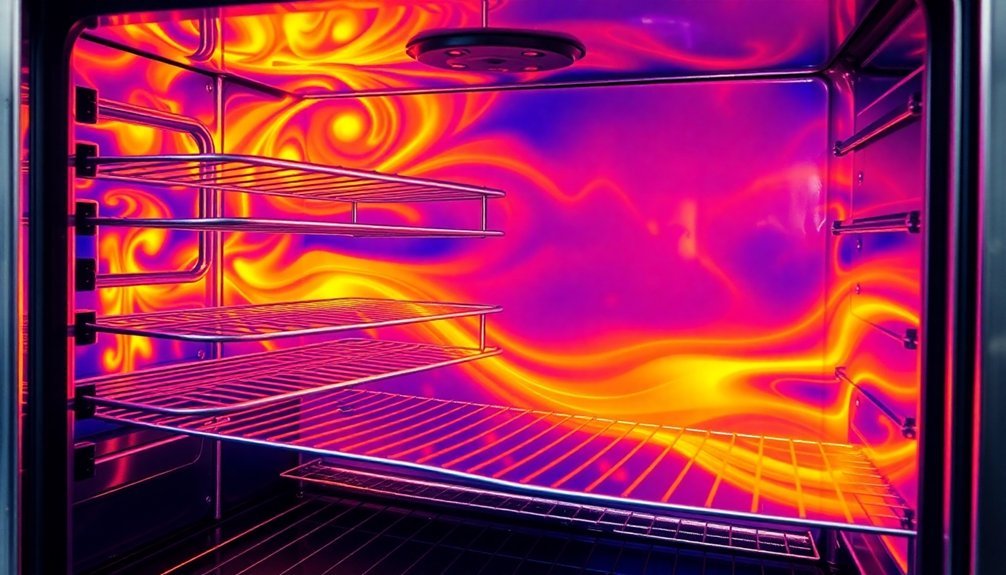You can enjoy outdoor winter cooking with these five proven methods. Start by building a dedicated winter cooking station using pallets or old tables, complete with a roof for weather protection. Master fire pit cooking by creating a secure perimeter and using hardwoods for consistent heat. Explore Dutch oven cooking, perfect for hearty stews and fresh-baked bread in the cold. Try winter grilling by positioning your grill away from wind and using extra fuel to maintain temperature. Keep food safe with proper storage techniques and temperature monitoring. These fundamental approaches will transform your outdoor winter cooking experience.
Building A Winter Cooking Station

When winter's chill arrives, building a proper outdoor cooking station becomes essential for safe and enjoyable cold-weather meal preparation.
Start by selecting a flat site away from deep holes and obstacles, then clear away all snow for stability. Create a stable fire area using bricks and guarantee you're far from flammable materials and overhanging branches.
Set up your station using old tables or pallets, and protect it with insulated materials and a roof to shield against snow and rain. Remember to wear warm, non-flammable clothing while working around the cooking area.
You'll want to incorporate storage space for keeping utensils, food, and fuel dry and accessible. Consider adding solar-powered lights for visibility and ceiling fans for ventilation.
Don't forget to arrange comfortable seating around your cooking area, making sure it's positioned safely away from the fire pit.
Fire Pit Cooking Basics
Fire pit cooking mastery begins with proper setup and safety protocols. Start by clearing an eight-foot radius from flammable objects and create a secure perimeter using rocks or green logs.
Position a large rock as a chimney at the rear to direct smoke away from your cooking area.
You'll want to build your fire strategically, starting with newspaper tinder and arranging kindling in a checkerboard pattern. Let it burn until you've got white coals, which provide the most consistent cooking temperature. Be sure to start the fire early, at least 60 minutes before you plan to cook.
For effective cooking, use a sturdy grate and adjust food placement to control heat exposure. Keep your cast iron cookware handy for perfect searing, and don't forget essential tools like fire pokers and heat-resistant gloves.
Remember to store a bucket of water nearby for safety, and always select hardwoods like oak for the best results.
Dutch Oven Mastery

Dutch oven cooking takes winter outdoor meals to new heights, building on the fundamental skills of fire pit cooking.
To master this technique, you'll need to prepare your cast iron Dutch oven properly by ensuring it's clean, dry, and lightly oiled to prevent rust. Rich, hearty dishes like beef bourguignon are perfect for Dutch oven cooking outdoors.
When cooking outdoors in cold weather, add 2-4 extra coals to compensate for lower temperatures. You'll want to use the ring method for coal placement, adjusting the circles wider or closer to control heat.
Don't forget to take into account wind conditions – use screens when necessary and rotate your Dutch oven to prevent hot spots.
For the best results, start by searing your ingredients before adding liquids, and use flavored broths instead of water.
You can even bake bread by trapping steam under the lid, creating a perfect winter comfort meal.
Grilling In Snow
Despite winter's chill, grilling in snow offers a uniquely rewarding outdoor cooking experience that you won't find in any other season.
You'll need to prepare your space by clearing snow, laying down salt for ice, and keeping your grill safely positioned away from structures. Use a grill cover to protect against the elements and make certain you've got extra fuel on hand, as winter grilling demands more energy. Stick to tried and tested recipes when cooking outdoors in winter conditions.
- Keep the lid closed as much as possible to maintain heat, and use a wireless thermometer to monitor temperatures.
- Shield your grill from wind while maintaining proper ventilation.
- Choose quick-cooking cuts like burgers or steaks to minimize time in the cold.
- Clean your grates thoroughly and use a water reservoir to prevent food from drying out.
Remember to wear heat-proof gloves and make certain proper lighting for safety.
Campfire Food Protection Methods

While mastering winter grilling takes skill, protecting your food during campfire cooking requires equally careful attention.
You'll need to keep raw meats in a separate cooler from produce and maintain temperatures below 41°F using ice packs. Don't forget to restock ice daily and store coolers in shaded areas away from direct sunlight.
To prevent cross-contamination, pack clean platters and utensils specifically for cooked foods.
You'll want to use a food thermometer to guarantee meats reach safe temperatures: 160°F for ground meat, 165°F for poultry, and 145°F for steaks.
Keep your hands clean with disposable wipes or eco-friendly soap, and sanitize all cooking surfaces.
If you're preparing ingredients ahead of time, store them in airtight containers and pack your cooler in reverse order of use.
Frequently Asked Questions
How Do You Prevent Metal Cooking Utensils From Becoming Too Cold to Handle?
You'll want to use insulated handle covers, silicone grips, or pot holders. Keep your utensils dry, store them in warm areas, and apply protective coatings. Choose cookware with built-in heat-resistant handles.
Can You Use Snow as a Water Source for Cooking Outdoors?
Yes, you can use snow for cooking water, but you'll need to boil it first. Start with seed water, add snow gradually, and remember you'll need about 5 times more snow than desired water volume.
What's the Best Way to Store Spices in Freezing Temperatures?
You'll need airtight, freezer-safe containers to store your spices in freezing temperatures. Keep them sealed completely to prevent moisture, and use small portions for daily use while storing bulk amounts separately.
How Do You Maintain Gas Pressure in Fuel Canisters During Cold Weather?
You'll maintain canister pressure by keeping fuel warm in your sleeping bag, using a propane-isobutane mix, placing it on an insulated base, and choosing stoves with pressure regulators for consistent performance.
Should You Pre-Heat Cookware Before Adding Food in Winter Conditions?
Yes, you should definitely preheat your cookware before adding food in winter. It'll guarantee even cooking, prevent sticking, reduce cooking time, and help maintain consistent temperatures. It's especially important for food safety.
In Summary
Don't let winter's chill keep you from outdoor cooking adventures. You've now got the knowledge to set up a protected cooking station, master fire pit techniques, create Dutch oven delicacies, grill through snowfall, and shield your food from the elements. Put these skills to work and you'll enjoy hot, flavorful meals in the crisp winter air. Remember, with proper preparation and safety measures, outdoor cooking is a year-round pleasure.





Leave a Reply